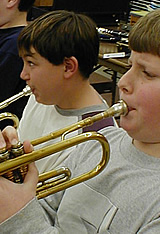| |

|
|
Historical Context
History of Legislation Affecting Arts Education
in California over the Past Three Decades
1970: Ryan Act. State law essentially eliminates arts-course
training requirements for elementary schoolteachers.
1978: Proposition 13. The landmark property-tax cap results
in school funding being shifted from local communities to the state. Districts
are forced to cut staff and programs, hitting the arts hard.
1983: High school reform. Among other things, a new law
requires high school students to take either one year of foreign language
OR visual or performing arts.
1989-90: Arts education report. Assembly Speaker Willie
Brown's Arts Education Task Force issues a report stressing the importance
of arts education, urging the California Arts Council and the Department
of Education to bring artists into the schools to help train teachers
as well as work with students.
1992: Arts partnership. The Local Arts Education Partnership
Program puts into practice the recommendations of the speaker's task force.
1992: Arts license plate. The arts partnership program
gets funding through the sale of a special license plate by the Department
of Motor Vehicles. Designed by painter Wayne Thiebaud, the palm tree plate
has provided $2.35 million for arts education since 1996.
1995:
Education Code Number 5121(Amended by Chapter 530,
1995)
Course of Study: Grades 1 to 6
(e) Visual and performing arts, including instruction in the subjects
of dance, music, theatre, and visual arts, aimed at the development
of aesthetic appreciation and the skills of creative expression.
Education Code Number 51220 (Amended by Chapter 530,
1995)
Areas of Study: Grades 7 to 12
(g) Visual and performing arts, including dance, music, theater, and
visual arts, with emphasis upon development of aesthetic appreciation
and the skills of creative expression.1997-98: New grants. In 1997,
state Superintendent of Schools Delaine Eastin forms a task force to
find ways to bring art and music back into the classroom, mobilizing
public officials and private arts groups. In 1998, the Department of
Education begins a grant program that now provides $6 million a year
for arts education. [Prop 98]
1999: University requirements added. Both UC and CSU
systems change admission requirements to include one year of visual or
performing arts, beginning in 2003.
2000: Arts budget increases. Gov. Gray Davis increases
the California Arts Council's annual budget to earmark $10 million for
education programs.
2000: Theatre and Dance Credential vetoed. Governor Gray
Davis vetoes AB752, which would have authorized the CA Commission on Teacher
Credentialing to create an emphasis credential in theatre and dance to
holders of English and physical education credentials, respectively. (Similar
credential bill sustained an earlier veto by Governor Wilson.)
2001: Teacher requirements change. The California Commission
on Teacher Credentialing alters its requirements for accreditation to
include some training in the teaching of visual and performing arts. Requirements
take effect in 2004.
2001: The state Board of Education adopts content standards for
the arts.
2003: California Arts Council budget cut by over 90%. Grantmaking
activities suspended, including arts in education grant programs.
2003:
SCR 5 (Scott) A far-reaching CAAE sponsored resolution
affirming the importance of standards-based instruction in the visual
and performing arts.
SB469 (Scott) Co-sponsored by CAAE and the CA State
PTA, the bill elevates the Visual and Performing Arts in the Instructional
Materials bill that was passed last year.
AB1512 (Cohn) Establishes the CDE Arts Work Grant Program
into statute, as separate and distinct from the Local Arts Education
Partnership.
SB611 (Ducheny) Makes clear the intent of the Legislature
to support all Subject Matter Projects, including the arts, health,
and foreign language. The intent will encourage the University of California
to continue maintenance funding in these three subject areas.
CA Master Plan for Education: CAAE advocacy responsible
for inclusion of visual and performing arts among academic areas to
be taught at all levels.
CDE Arts Work grants: $6 million eliminated in Gov.
Davis’ budget and later restored by Legislature.
2004:
CDE Arts Work grants: $6 million eliminated in Gov.
Schwarzenegger’s budget and later restored by Legislature. Status:
Cut by Governor Schwarzenegger on August 12, 2004 in signing message
for SB1108:
“While I am supportive of arts programs, this small, competitive
grant program serves relatively few schools. These funds, which count
towards Proposition 98 2003-04 obligations, will be appropriated to
schools at a future date. During this time of fiscal difficulties, these
funds should be spent for educational priorities agreed to with the
education leaders to provide more flexible funding so local schools
can fund their most important needs.”
SB 1213 (Scott) Increased fees for arts license plate
Increases the amount of the fees imposed for issuance and renewal of
specified special interest license plates approved by the DMV in consultation
with the California Arts Council. Requires the council to use the revenue
exclusively for arts education and local arts programming. Prohibits
the council from using the revenue for its administrative costs.
Selected text excerpted from ©2002 San Francisco Chronicle.
 [updated
6/30/05] [top of page] [updated
6/30/05] [top of page]
|




